FUTURE STYLE
|
Emagic Logic Pro 6  Professional music composition, audio recording, sound generation, notation editing, post production 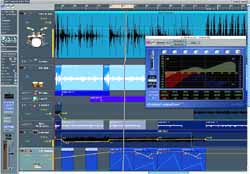 System Requirements - Mac OS 9.1 or higher - Mac OS X 10.2 or higher - G3/400Mhz or faster - 128 MB RAM or more (256 MB recommended) - CD ROM or DVD drive - free USB port for XSKey - MIDI Interface and MIDI keyboard - Low latency audio hardware recommended - Separate Harddisc recommended Logic Pro 6 is a software solution for the professional musician and producer which contains the Logic Platinum 6 music production software plus the complete Apple/Emagic DSP and audio instrument product line. Music composition, audio recording, multimedia, sound generation, movie scoring and remixing ... Logic Pro 6 provides an all-in-one solution for professional musical projects and audio productions. Processing od Audio and MIDI The Arrange 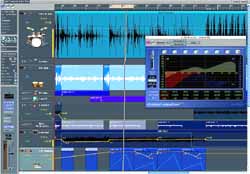 larger size The Arrange window provides you with a number of graphical objects that can be rearranged and edited in a number of ways to form a song in Logic Pro 6. Audio recordings and MIDI keyboard performances are captured and displayed in a linear roll , vertically divided into tracks. You can even incorporate thumbnails of a QuickTime movie in this track view as well, when scoring a movie, TV show or an advertisement. Beyond the rearrangement of graphical audio and MIDI objects, numerous editing possibilities are available in the Arrange. Time Stretching, for example, allows the length of an audio object to be quickly and easily adjusted to match a chosen number of bars , without affecting the pitch of your audio. The Marquee Tool assists in selection of specific portions of your graphical audio and MIDI objects, allowing precise move, copy, delete or cut edits. The channel strip of the selected track is displayed on the left of the Arrange. This facilitates fast access to mixing parameters directly from the Arrange, enabling you to see and graphically edit parameters of the mixer, internal effect plug-ins and software instruments as well as those of external MIDI devices. You can freely customize the way the Arrange is displayed by selecting different zoom levels for each track plus several other visual options. This flexibility allows you to create a central interface for your projects, offering an optimized overview. Audio Recording And Editing  larger size Logic Pro 6 supports audio at (16 and) 24 Bit resolution and sample rates of up to 192 kHz , for both audio recordings and playback of internal software instruments. This high level of sonic quality is maintained throughout the project (even during mixdown to 16 Bit audio for CD release) thanks to the integrated POW-r dithering algorithm. A sample editor is integrated into Logic Pro 6, allowing precise editing of your audio data. Beyond simple operations such as: cut, copy and paste an extensive suite of DSP processing tools are also available. These tools include: time stretching, pitch shifting and formant correction. Further processing possibilities are afforded by the option of inserting Premiere and Audiosuite plug-ins. Logic Pro 6 features integrated support of ProTool HD systems. You can link the native signal processing of the computer with the DSP hardware of TDM systems via the optional Emagic System Bridge (ESB TDM). This combination of the native and TDM systems ensures that all available processing power is available for your use. ESB TDM also extends the functionality of the EXS24 by allowing it's insertion into Aux channels of the Logic Pro 6 TDM mixer. MIDI And Score 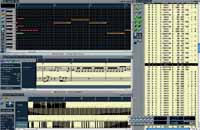 larger size You can freely record your MIDI melodies and arrangements via USB MIDI keyboards or interfaces. Near unlimited number of MIDI tracks allows the creation of vast arrangements. An extensive selection of editors provide access to your MIDI data: the Matrix and Hyper editors both provide edits via the manipulation of graphical objects. The alphanumeric Event editor provides comprehensive information on every detail of recorded MIDI events. The Score editor transforms MIDI performances into notation ( in realtime) as you're playing. Elaborate layout functions and professional notation printout functions allow you to quickly deliver anything from a lead sheet to a complete orchestral score. Automatic transposition of different instruments is supported, as well as guitar tablature, drum notation and rapid entry of song lyrics or performance notes. The Environment provides you with a virtual representation of your physical MIDI hardware. The entire data flow is visible onscreen. MIDI processing objects such as arpeggiators, chord memorizers, faders and delays can be inserted at almost any point in the data flow. The Environment provides you with the tools to perform a range of tasks. As examples, you could construct dedicated remote controllers for MIDI devices, build a drum computer or step sequencer, or simply fade between two audio tracks with the modulation wheel. Mixer The virtual mixer of Logic Pro 6 controls a maximum of 255 audio tracks, 64 audio instrument tracks, and a nearly unlimited number of MIDI tracks. Each audio and audio instrument track can display and use up to 15 insert plug-ins and 8 effect bus sends. Logic Pro offers over 50 integrated effect plug-ins and supports additional AU format (Mac OS X) or VST format (Mac OS 9) plug-ins. Logic Pro 6 also features an exclusive collection of software instruments as well. As with the effects, additional instrument plug-ins are integrated via AU in Mac OS X and via VST2.0 in Mac OS 9. The parameters of software instruments and effects, as well as the controllers of the mixing desk, are integrated into the automation system of Logic Pro 6 allowing full, total recall mixes. The mixer further supports a range of hardware controllers, spanning from simple models for the home studio up to high-end professional control surfaces that are deeply integrated into the Logic system. Your final mix is written to your hard drive in industry standard formats such as: SDII, WAV, AIFF and MP3 (in Mac OS X). Logic Pro 6 also features support for 12 surround formats, making it ideal for those involved with soundtrack work. Key Features – Sequencer General - Ultra-precise 32 Bit internal processing - Event resolution 1/3,840 note - Tempo resolution accurate to 1/10,000 bpm in the range from 0.05 to 9,999 bpm - Freely configurable user interface - 90 freely configurable Screensets per song - Over 800 freely definable Key and MIDI commands for all important program functions - Interactive windows with Catch/Link/Content Link - Individually zoomable/resizable tracks - Optimized user interface offering fast navigation - New online help system - Localized menus, multilingual interface - Synchronized Quicktime video support - Adaptive, self-configuring Track Mixer for MIDI & audio - Comprehensive for hardware controllers: Tascam's FW1884, US-428, US-224, Mackie HUI and the HUI emulation of Yamaha's DM2000/1000 and 02R96, Motormix from C.M., Roland SI-24 and Radical SAC-2k and SAC-2.2 support MIDI - Virtually unlimited number of MIDI tracks - Realtime MIDI quantize, Groove Templates - Matrix, Event, Hyper and Transform Editors - Time signature and key change Editor - Score Editor: realtime notation, coloured notes, steptime input window, professional layout/printout - HyperDraw™ for all event types in Arrange, Matrix and Score Editor - Sophisticated MIDI processing Environment - Touch Tracks: live playing of folders/sequencies - AMT for precise MIDI timing with AMT8/Unitor8 - Up to 128 MIDI ports supported - OMS/MTP compatible - Full synchronization options with MTC, MMC, SMPTE - AutoLink with SoundDiver (Mac OS 9) Automation - All-new, track-based, sample-accurate automation engine for virtually every parameter including effect plug-ins and Audio Instruments - Independent of sequencer record status - Read, write, latch and touch modes - 32 Bit automation data resolution - Automated parameters are displayed with full name and value - Color-coded automation data is displayed directly in Arrange window as envelope with break points - Break points can be freely drawn, edited and scaled - Automation curves freely adjustable between convex, concave, s-form or linear shapes - Automation data can be moved or copied with corresponding audio data, or independently Plug-Ins and Audio-Instruments - Up to 64 Audio Instruments for insertion of Emagic, Audio Unit (Mac OS X) and VST2 (Mac OS 9) virtual instruments - 15 inserts for plug-ins and 8 sends per Audio Instrument - 3 new Emagic instruments included – ES M monophonic, ES P polyphonic and ES E for ensemble sounds - ES1, ES2, EXS24 mk II, EVP88, EVB3, EDV6 - Audio Unit (Mac OS X) and VST/VST2 (Mac OS 9) realtime plug-in support - Over 50 effect plug-ins included: various delays, reverbs, distortions, dynamics, modulation effects, BitCrusher, Auto Filter, Enveloper, Spectral Gate, etc. Of these, Phase/Clip Distortion, Denoiser, DeEsser, Tremolo, Stereo Spread, Exciter, SubBass, Limiter, Adaptive Limiter, Multiband Compressor are new. - EVOC20 vocoder/filterbank package - Sidechains for plug-ins and Audio Instruments - ReWire support for ReBirth and Reason - Adobe Premiere & AudioSuite plug-in support (Mac OS 9) Audio - Audio resolution up to 24 Bit/96 kHz - Up to 128 stereo audio tracks (single hardware) - Up to 255 stereo audio tracks (multi hardware) - High-end POW-r dithering Algorithm - Hardware independent audio scrubbing - 8 channel surround mixing in any of 12 formats - comprehensive Channel EQ with 8 bands per track - 15 FX inserts per track, 8 effect sends per track - Audio input objects with 15 FX inserts and 8 sends - 64 stereo busses for subgroups and FX returns - 16 inserts per bus, 16 inserts per output object - Bouncing with realtime effects - Integrated stereo sample editor with Time and Pitch Machine II™ with formant correction, Audio to Score, Quantize Audio/Groove Machine and more - Cycle-Recording for Audio, quick Punch on the fly - Fit MIDI tempo to audio, Strip Silence function - REX2 file support in Arrange and EXS24 - OMF (Avid/ProTools) and Open TL import/export Supported Audio Hardware (tracks) - Emagic Audio Engine (up to 128 stereo tracks per driver class): Core Audio (Mac OS X), Mac AV, EASI, ASIO, Direct I/O, Audiowerk2/8 (Mac OS 9) - Roland VS (Arrange editing) (8/16) - Korg 1212 I/O (96) - Sonorus StudI/O (96) - Digidesign DAE (8) - Digidesign TDM (ProTools III/24/24MIX, 24MIX+, MIX3, HD Accel) inc. TDM plug-ins and Surround (16-64) - Cascade 3 x Audiowerk8 for output expansion - Virtually unlimited multiple hardware support (Mac OS 9) Key Features – Logic Pro Instruments -32 Bit sound engine for high-end sound quality -Sample accurate playback timing -Perfectly integrated into Logic’s digital mixer including full automation and access to all Logic effects -Intuitive, ergonomic user interface -Logic Control support EXS24 mk II: General -Up to 64 EXS24 mk II with up to 64 voice polyphony each* -Integrated Logic stereo sample editor with loop editing -Intelligent automapping of samples -Flexible library management using hierarchical menus Compatibility -Reads AIFF, WAV and SDII with 8 to 24 Bit, 11 to 192 kHz -Imports REX2, AKAI S1000/S3000, GigaSampler, SampleCell II and SoundFont 2 sample formats -Provides an interface for the Vienna Symphonic Library Performance Tool -Sound Processing per Voice -Multimode filter (highpass, lowpass, bandpass) with adjustable slope, Fatness circuit for full bass response -Simultaneous control of filter cutoff and resonance -Filter may be switched off to increase polyphony -Extensive modulation section with modulation source, destination and additional source to modulate amount -2 ADSR envelopes with key tracking and variable attack phases with linear or logarithmic curves -1 polyphonic LFO with decay/delay envelope, 2 monophonic LFOs run freely or in tempo-synced note values -Analog feel, tuning and glide with pitch envelope -Poly, mono or legato mode ES2: General -Optimized for Macintosh Velocity engine -Up to 64 ES2 units each with up to 32 note polyphony -Poly, mono and unison modes with Glide and Legato for automatic portamento -Intelligent random sound programming with adjustable intensity and destination Effects -Adjustable, powerful distortion effect with soft and hard characteristics -High-quality modulation effects such as chorus, phaser or flanger Oscillators per Voice -3 Oscillators with classic analogue and 100 digital waveforms, plus noise -Frequency Modulation, Oscillator Synchronization, Pulse Width Modulation and Ring Modulation -Dynamic Wavetable Scanning of the digital waves via freely selectable modulation sources -Dynamic Vector control of oscillator mix and two additional, freely selectable parameters Filters per Voice -1 multimode filter (N/BP/HP/LP/Peak) with overdrive -1 lowpass filter (12,18,24 dB) with filter FM and unique Fatness circuit -Filters can be connected in serial or parallel modes Modulations per Voice -2 ADSR envelopes with sustain time parameter, velocity can control level and attack -1 monophonic or polyphonic AD/AR envelope, velocity can control attack -2 LFOs with 7 waveforms -LFO1 is polyphonic with key-sync, and offers its own decay/delay envelope -LFO2 is monophonic, and can be synced to song tempo -10 freely definable modulation paths (20 sources and 30 destinations) with modulatable intensities -1 Vector envelope with 15 points, loop mode and adjustable tempo sync controls oscillator mix and two additional, freely selectable parameters ES1: General -Up to 64 ES1 units each with up to 16 note polyphony* -Portamento with poly, mono or legato mode -Integrated emulation of “classic” Chorus/Ensemble effects -Variable simulation of analog circuitry Per Voice -Main Oscillator with 3 waveforms – saw, triangle, variable pulse wave with pulse width modulation -Oscillator range from 2 to 32 feet -Sub Oscillator with 5 waveform plus noise and external audio input via the side chain -One monophonic LFO (can run freely or in adjustable bar/ beat values with sync to tempo) -6 LFO wave forms including stepped sine, sample& hold, smoothed sample&hold, triangle, up/down sawtooth as well as an input for an external audio modulation signal, LFO amount is controllable by the Modulation Wheel -Ultra-fast ADSR envelope and Modulation envelope -Modulations amount of both envelopes can be controlled via key velocity -LFO and modulation envelope control via the modulation matrix: pitch, oscillator mix, puls width, filter cutoff, resonance, volume, filter FM and LFO amount -Lowpass filter with resonance and adjustable overdrive, 3 filter slopes (12, 18, 24 dB) and fat filter mode -The filter cutoff can be modulated by the main oscillator with frequencies in the audio range (filter FM) -An external audio signal can be routed through the ES1 filter/ synthesizer engine -ADSR envelope (for filter and amplifier) gate with release, gate with attack and release (amplifier) EVP88: General -12 authentic realtime replications and variations of legendary vintage electric pianos -Original dynamics faithfully reproduced -Fully polyphonic over 88 keys, up to 88 voices (computer dependent) -Stylish retro-look, with ergonomic controls for detailed sound adjustment -Up to 64 EVP88 units simultaneously* Models -The tone generation is based on a detailed physical simulation. It includes the movements of the various electric piano reeds, tines and tone bars in the electro-magnetic fields of the pikkups. It also synthesizes the transients of the attack phase, as well as the hammer action and damper noises. -Fender Rhodes models: Suitcase Mark I, Stage Piano Mark I/Mark II, Bright Stage Mark II, Hard Stage Mark II, Mark IV, Metal Piano (variation), Attack Piano (variation) -Wurlitzer models: Wurlitzer 200 A, Soft Wurlitzer, Funk Wurlitzer (variation) Hohner model: Electra Piano Modifying Tonal Characteristics -All parameter changes can be stored as programs -Parameters for detailed sound editing: model, voices, tune, decay, release, bell, damper, intensity, stretched tuning lower/upper, warmth -Full MIDI control of all sound editing parameters Effects Section (Parameters) -Extensive and authentic vintage effects with Equalizer (Treble, Bass), Overdrive (Gain, Tone), Phaser (Rate, Color, Stereophase), Tremolo (Rate, Intensity, Stereophase) and Chorus (Intensity) EVB3: General -Authentic, realtime emulation of the Hammond B3 Tonewheel Organ including a realistic emulation of the Leslie Rotor Cabinet -Full polyphony, up to 195 Voices per EVB3* -Up to 64 EVB3 simultaneously* -Stylish, intuitive user interface -Adjustable to single or multiple keyboard setups -Parameter changes can be stored as Settings Tone Generation -Realtime Hybrid Component Modeling -Detailed simulation of all electromechanical components of the original B3 tone generation, including key click noises and crosstalk -Detailed parameter set to modify the characteristical properties of the B3 sound -Drawbar control system provides over 250 million combinations, 12 adjustable drawbar presets per manual with preset morphing for upper manual Sound parameters -Upper and Lower Manual feature two sets of 9 drawbars with 9 settings each -Bass Pedal features 2 drawbars with 9 settings each -Parameter to control: Click, Click Color, Crosstalk, Random FM, Drawbar Leakage, Filter Age, Stretch Tuning, Transpose and many more Effects -Rotor Cabinet emulation based on classic cabinet models with Chorale, Brake and Tremolo modes, selectable cabinet, adjustable microphone position and motor control -Scanner Vibrato (6 Types) with Chorus -3 band EQ and Reverb -Wah Wah effect with 6 classic filter types -Tube Distortion with 3 distortion types -Rotor Cabinet, Vibrato and Tube Distortion are available as separate plug-ins EVD6: General -Authentic, real-time emulation of the Hohner Clavinet D6 -Various selectable instrument models -Up to 24 note polyphony per EVD6 unit* -Up to 64 EVD6 units* -All parameter modifications can be stored as Settings Tone Generation -Realtime Algorithmic Component Modeling -Detailed simulation of the original electromechanical -D6 tone generation including string properties and pickup simulation -Detailed control over of the sound characteristics when striking and releasing the Clavinet keys -High-resolution controls provide precise control over string Decay, Release, Damping, Tension Modulation, Stiffness, Inharmonicity, Pitch Fall -Graphical editing of the pickup positions -4 pickup configurations -Stereo Spread control for Pickups und key position -Rocker switches for Filter section with Brilliant, Treble, Medium and Soft settings Damper control Effects -3 integrated effects with selectable serial effect configurations -Integrated Phaser/Chorus/Flanger with adjustable Rate and Intensity controls -Integrated Wah Wah with adjustable Range and Envelope (AutoWah) -6 classic vintage Wah Wah filter models -Wah Wah filter cutoff controllable via MIDI controller -Integrated Distortion with adjustable Compression, Tone and Gain controls -Separate Logic effect plug-in including Wah Wah and Distortion with additional parameters Sound Generation A collection of software instruments All of the instruments offer the same level of sound quality, achieved through the use of 32 Bit internal processing. The utilization of modern technologies, such as component modelling algorithms, are the basis for calculating the most complex of sounds in real time. The exclusive selection of instruments offered by Logic Pro 6 features a software sampler, synthesizer and virtual vintage keyboards, including the Hammond B3 Organ and Hohner D6 Clavinet. The integration of these instruments into Logic Pro 6 guarantees optimal handling and processing, no matter where you wish to use the system (on stage or in the studio). You can even use it while travelling ... on your PowerBook. The instruments are easily inserted into an audio instrument channel strip of the Logic Mixer. The integrated track-based automation system of Logic Pro 6 allows you to graphically display and edit the parameters of the instruments, and if you have a hardware controller, these parameters can be adjusted and recorded as well. Sampler 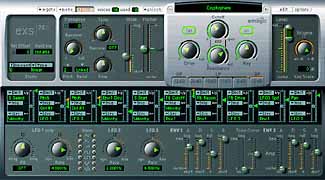 EXS24 mk II The EXS24 mk II software sampler let you easily and quickly incorporate sample-based sounds into your productions, with sound quality of up to 24 Bit/192 kHz resolution. The EXS24 mk II offers support for a wide range of sample library formats, including: EXS24 native, Akai, GigaSampler, SampleCell II, SoundFont2 and REX2, providing users with access to a huge number of sound libraries. The EXS24 mk II allows the use of sample libraries, as memory is only limited by the computer's RAM or by hard disk capacity (when using virtual sample memory (VSM). The EXS24 mk II features sample-accurate timing, total recall and an intuitive operating concept. If desired, up to 16 individual outputs can be addressed, allowing further processing of EXS24 mk II sounds with Logic Pro's extensive range of effect plug-ins. The modulation matrix, borrowed from the ES2 synthesizer, provides routing possibilities, allowing countless creative sound processing options. Sources include: the three LFOs, the two snappy envelopes, any MIDI-Controller, or the level of the sidechain input can be routed to Sample Select, Sample Start, Pitch, Glide, Volume, Pan, envelope times, parameters of LFOs or filters. A sounding multi-mode filter completes the feature set, providing adjustable slopes, variable filter overdrive amount, and a fatness circuit that ensures low frequency response, even at high resonance settings. Additionally, Logic Pro's ESB TDM allows the direct insertion of up to 32 instances of Emagic's Xtreme Sampler 24 Bit into the Aux channels of Logic's TDM mixer. The stereo output signals of each EXS24 instance can be treated via any of the processing options afforded by the TDM DSP environment, such as TDM plug-ins. Each EXS24 TDM is calculated by the host CPU, and places no overhead on the TDM DSPs. The MIDI performances of each EXS24 TDM instance are recorded on TDM Auxiliary tracks, and are controlled directly in Pro6' Logic Platinum. This eliminates the need for OMS, thereby providing the benefit of sample-accurate playback for all instances of the EXS24 TDM. Synths ES2  larger size Emagic‘s ES2 offers an innovative software synthesizer that combines the full-bodied warmth of subtractive synthesis with the possibilities of digital tone generation systems such as vector synthesis and frequency modulation (FM). Musicians and sound designers can draw from a whole host of sounds and a range of synthesis techniques to crerate sounds. The same level of flexibility also extends to the huge number of modulation options. ES2 allows the random generation of sounds, a unisono-mode and the innovative ConstantBeatDetune function. The latter allows floating frequencies over the complete key range. Use up to 64 ES2 simultaneously, depending on the Logic version and computer power available. Each ES2 has 32 voices, each offering three especially flexible oscillators, two filters and extensive modulation possibilities. Select Unison, and layer up to 32 voices. Processor optimizations for modern computers ensure maximum possible performance. Oscillators In addition to the classic triangle, square, sawtooth and noise waveforms, each of the three oscillators in an ES2 voice can generate 100 digital waveforms. Wavetable Scanning without any audible steps determines which of these digital waveforms is heard. This can be dynamically modulated in realtime to provide animated textures. Add to this Oscillator Synchronization for aggression and Pulsewidth Modulation for movement. A Ring Modulator offers unpolished metal, and with Linear Frequency Modulation, the ES2 can easily generate sounds known from famous FM synthesizers. Vector Synthesis Regardless of the synthesis technique you choose to use, the Vector envelope can store up to 15 oscillator mixes plus the values of two additional, freely selectable parameters and crossfade automatically, and dynamically, between these points. Imagine, for example, a sound starting with coloured noise, transforming into a bell, and ending with an FM bass. The Vector envelope even runs in sync with song tempo, if desired. Filters This dynamic oscillator mix is then passed through two resonance-capable filters: a multimode and a lowpass filter. These can be connected in serial or parallel modes, a process that is not only clearly audible, but graphically displayed as well. The multimode filter can be used as a peak, band reject, low-, band- or highpass filter and offers an adjustable distortion circuit. The separate lowpass filter offers three slopes; for harsh to metallic sounds, its frequency can be modulated from oscillator 1. The fatness circuit ensures fat basses, even at high resonance settings. For sonic variety normally otherwise found in modular hardware synthesizers, the proportions of both filters can be adjusted in both serial and parallel modes. And if you are looking for really deep basses, just mix the sine wave of oscillator 1 with the filters’ output. Modulations and Effects Beside a multitude of MIDI signals, each voice offers two LFOs, one of which is tempo-syncable, and three exceedingly fast envelopes, as modulation sources. Using ten freely assignable modulation paths, these 20 sources can be routed to 30 destinations, allowing almost every parameter of the ES2 to be controlled. And the modulation intensity of each modulation path itself can also be modulated by one of the 20 sources. An additional modulation effect provides high-quality chorus, phaser or flanger, providing the finishing touch to all sonic creations. Over 400 sounds created by renowned sound designers are already included. ES1  larger size The ES1 software synthesizer offers up to 16 voice polyphony, every ES1 voice features a main and sub-oscillator delivering the raw sonic material shaped by the analog ES1 filter. Each oscillator features a set of “classic” waveforms including triangle, sawtooth and variable pulse. The sub-oscillator, with its own five waveforms, operates one or two octaves below the main oscillator adding a solid bass fundament. Additionally the suboscillator provides a noise scource and an input for an external audio signal allowing audio tracks to be processed with rhythmically changing filter movements. ESM, ESE, ESP  larger size The ESM is a monophonic Bass Synthesizer that is ideal for the creation of powerful basses and expressive lead sounds. It provides variable selection between sawtooth and rectangular waves. A source of particular pleasure is the resonance-capable dynamic low-pass filter, with a biting slope characterisic of 24 dB. One of the strengths of the eight-voice polyphonic ESP are the characteristic 80ies pop music synthesizer brass sounds, for example. In addition to the oscillator, sub-oscillator and filter, the ESP offers an LFO for creating wah-wah-effects and an ADSR envelope generator for precise level control. The ESE is an eight-voice polyphonic synthesizer as well. It is specially designed for pad-sounds. The basis of its sound generation are sawtooth or rectangular waves, that can be mixed in a near-infinite variety of base tones. The sawtooth wave can be modulated in frequency, the rectangular wave in impulse width. The ESE further offers selectable arrack and release times, a dynamic low-pass filter and a three-step chorus/ensemble effect. Vintage instruments EVP88  larger size Emagic Vintage Piano 88 Fender Rhodes, Wurlitzer, Hohner .... the sounds of these original instruments can be used in the Logic system . In the EVP88 all sounds are reproduced authentically, without the use of samples. This modelling technique results in a software instrument that responds to every subtle playing nuance with high dynamism. In addition, the deep integration of the EVP88 into Logic guarantees stability, ease-of-use and total recall automation. Tone Generation While vintage Fender Rhodes, Wurlitzer and Hohner electric pianos produce their sounds electromechanically, the EVP88 digitally produces accurate replications, via native realtime tone generation. The EVP88 does not just statically recreate an instrument's tonal characteristics, as would be the case with samples. Rather, it expressively reacts to the player's every nuance with realism. And like its vintage hardware predecessors, the EVP 88 can be played with full polyphony over a range of 88 notes, with 88 voices. The EVP88 provides sounds from electric pianos such as the Fender Rhodes Mark I of the Suitcase and Mark I & II of the Stage series, the Wurlitzer Electric Piano 200A and the Hohner Electra Piano, as well as many tasteful variations. A key element of the effects section of the EVP88 is the 2 band EQ for bass and treble manipulation, based on Emagic's renowned Fat EQ. The Drive circuit with gain and tone controls gives the sound the right bite. A four step Phaser with color control and built-in distortion adds further warmth and animation. The Tremolo, with rate and intensity controls, recreates the classic effects that made so many Rhodes passages so memorable. Both Phaser and Tremolo have an adjustable stereophase control to help create a broad spectrum of stereo effects. The variable intensity Chorus adds a final high-quality shimmer. EVB3  larger size Hammond Sound The Hammond B3 organ is one of the most influential keyboard instruments of the 20th century. The characteristic B3 sound has been, and continues to be heard, in a wide range of musical styles such as Motown, Jazz, Pop, Rock, Funk, Reggae, Dance, Country, Blues, Soul and Gospel. The EVB3 flawlessly recreates the sound of the B3 in software. The user interface is intuitive, and offers more tonal flexibility than the original instrument. EVD6  larger size A funky Instrument . Hohner Clavinet D6 sound. Although the D6 has always been closely linked to funk, the sound is used in countless pop, reggae and dance productions. The EVD6 mathematically recreates every subtle nuance of the original without using any samples, making it an extremely playable instrument. Using a realtime Component Modeling algorithm, each aspect of the Hohner Clavinet D6 has been modelled in the EVD6. No samples are used during the realtime tone generation process, providing an emulation that captures the essence of the original with up to 24 voices. This modelled approach has ensured that, like the original Hohner Clavinets, the sound of the EVD6 reacts realistically, and dynamically, to every nuance of your performance, including the typical string noises on key-release. Subtle playing results in, not only a lower volume, but also a softer sound. Sound Processing This "native" sound processing , calculated directly on the computer processor(s), substitutes the use of external DSP's (Digital Signal Processors) and effect devices. Logic Pro 6 delivers over 50 realtime effect plug-ins, allowing for the most innovative audio processing. The basic technical specifications (32 Bit floating point mathematics and support of audio resolutions up to 24 Bit/192 kHz) ensure ) sound quality. In addition to the built-in effect system, Digidesign’s TDM system for ProTools hardware is completely supported, including surround. Depending on the configuration, up to 64 audio tracks and 64 busses are available. TDM plug-ins from all major developers can be used and fully automated. I/O inserts even allow the integration of external audio effect processors. Reverb Space Designer The Space Designer is a reverb plug-in for the Logic Series. Using a real-time calculation process, Space Designer merges the input signal with a reverberation sample, the impulse response (IR) , taken from any acoustic space such as, for example, a room, hall, or cathedral. The result sounds as if the input signal had actually been recorded directly in the sampled room. The reverb can be further shaped using Space Designer’s parameter set. Space Designer ships with a library of over 1,000 impulse responses. These include real rooms and halls, as well as classic and contemporary reverb units. In addition, you can always record your own impulse responses.  larger size 5b Space Designer uses a reverberation method that features specially designed envelopes to create high-quality synthetic reverbs. The results are dense and smooth reverbs. No matter if you use IR samples or prefer to create your own, the reverb sound can be customized quickly using Space Designer’s envelopes for volume, filter, and density. Smooth envelope shapes can be modeled onscreen with ease. The 12 or 6 dB low pass, band pass, or high pass filter is equally suited for fine-tuning your reverb sound as well as for creating experimental sound effects. As with all Emagic plug-ins, Space Designer supports sample rates up to 192 kHz. PlatinumVerb  larger size GoldVerb  larger size SilverVerb  larger size EnVerb larger size Filter / Vocoder The EVOC20 package provides Logic users with three tools for sound design: A classic polyphonic vocoder with built-in synthesizer, a formant filter bank, and a pitch tracking vocoder. Each plug-in provides 32 Bit sound quality. The EVOC 20 PS combines a vocoder with a polyphonic synthesizer, playable in realtime. Each of its 16 voices features two oscillators with 50 special waveforms, FM capabilities and colored noise. This synthesis signal can be articulated by any input signal, giving you classic sounds like talking robots, singing strings, percussive choirs and more. Up to 20 filter bands can be used for the articulation process. The Unvoiced/Voiced Detector increases speech audibility. Formants can be spread, moved or modulated by the syncable LFO for subtle or extreme sonic transformations. The Ensemble effect provides warm, swirling sound.  larger size The EVOC 20 TO (Tracking Oscillator) architecture is similar to that of the EVOC020 PS: up to 20 filter bands, modulatable formants, controllable filter resonance for sharp or soft vocoder sounds, Freeze, adjustable reaction times and the U/V Detection circuit. But the EVOC 20 TO differs fundamentally from the polyphonic vocoder in its use of an audio track, or the monophonic pitch tracking oscillator, for the synthesis signal. The pitch tracking oscillator follows the pitch of the analytic signal with great accuracy. The oscillator’s waveform can be switched between sawtooth and 2 oscillator FM.  larger size The EVOC20 FB (analogue Filter Bank) offers the core of every vocoder, with two distinct, fully adjustable filter banks (A/B). The input signal runs through both filter banks in parallel. Each provides up to 20 filter bands, which can be blended manually or via a syncable LFO. Each discrete filter band features independent level controls with the option to dampen frequencies up to 100%. Additional filter resonance, adjustable filter slopes, and optional distortion ensures an expansive range of tone colorings. A second LFO, syncable to song tempo, facilitates the modulation of formants through the movement of filter bands. Formant movements can also be manually achieved. Filters Autofilter, Fuzz - Wah , Delays, Distortion, Dynamics, Modulatio  larger size The AutoFilter creates effects in the style of classical analog hardware synthesizers. It features a selectable low-pass filter slope (6, 12, 18 or 24dB), a complete ADSR and a full featured LFO, with speed modulation on the input signal. As higher resonance values cause the filter to cut out the bottom end, the signal ends up sounding thinner. The Fatness parameter compensates for this audio artefact. For f aggressive sounds there is a distortion effect on the input and output of the Autofilter. The resonance controller invites you to experiment, as self-oscillation is initiated before you max out the parameter. Fuzz - Wah vintage plug-in. The Fuzz and Wah effects are combined in a single plug-in that can be used to process any sound source in the Logic mixer. 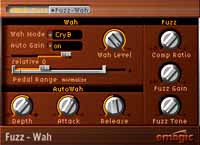 Fuzz Wah. The Wah effect provides 6 different filter types that simulate legendary effect pedals such as the Morley or CryBaby. The envelope can be changed and automated onscreen or controlled via MIDI. The distortion of the Fuzz-Wah works on frequencies between 2000Hz and 20,000 Hz. Every sonic detail can be controlled with parameters that influence intensity or compression, for example. The AutoGain function guarantees the maximum peak, without overloads. Delays  larger size  larger size Specials filters Gate  In a user-definable frequency range, you can make different parts of the signal separately audible: above (Super Energy) and under (Sub Energy) the Threshold level. The isolated monitoring of Super Energy, for example, could be described as vocoder-like. Additionally, the original signal (outside the defined frequency band) can be added to the mix: Low Level blends in the frequencies that lie below the frequency band, and High Level,the frequencies that lie above the defined frequency band. The 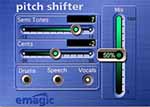 Pitch Shifter The Pitch Shifter detunes the signal in semitones and in Cents (1/100th of a semitone step). Three different algorithms (Drums, Speech, Vocals) are offered to fit different source material. Selecting Drums leaves the groove of the original track intact. Vocals is well-suited for any signals that are inherently harmonic or melodious. Speech is a mixture of both, and is useful for complex signals such as spoken words. 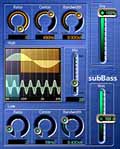 larger size Subbass The SubBass plug-in increases the frequency spectrum of the signal with frequencies that are lower than the original sounds. One simple use of the SubBass is as a classic Octaver. As the bass signals generated by the SubBass are derived from two selectable frequency ranges in the original signal, it also makes the effect suitable for use on complex summed signals. 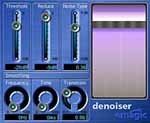 Denoiser The Denoiser cleans your recordings, by separating the desired signal from the noise floor. No matter whether it is a high blue or dark pink noise, the noise level of any audio source can be reduced, while retaining the highest possible dynamic levels. 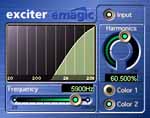 Exciter The Exciter adds high frequency components to the input signal. The effect can be described as a non-linear distortion. In contrast to overdrive and distortion effects, the harmonics generator is fed by a high-pass-filtered version of the input signal.  Stereo Spread This plug-in is useful particularly when mastering. It extends the stereo base by alternately distributing a selected number of frequency bands from the middle frequency range to the left and right channels. This effect is suited to giving monaural recordings a stereo effect, without the usual "alien“ artefacts associated with the process. |
|
EMAGIC SOFT- UND HARDWARE, Halstenbeker Weg 96, 25462 Rellingen, Germany Tel.: +49-4101-495-0, Fax: +49-4101-495-199, info Emagic Italy: Digimedia, tel.(++39) 0248702843, e-mail
|
advanced technologic sound magazine 2004 february issue 122
|
